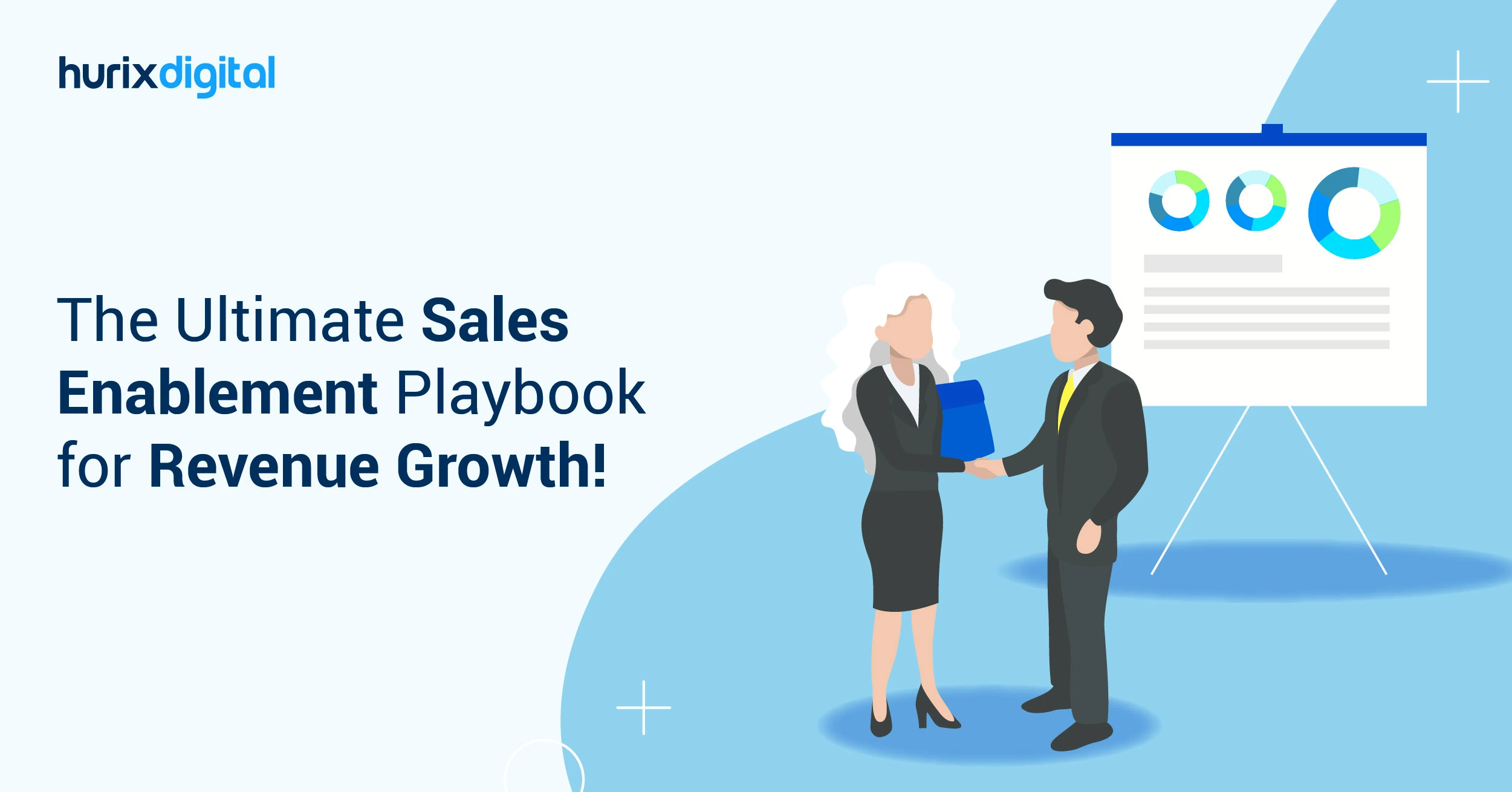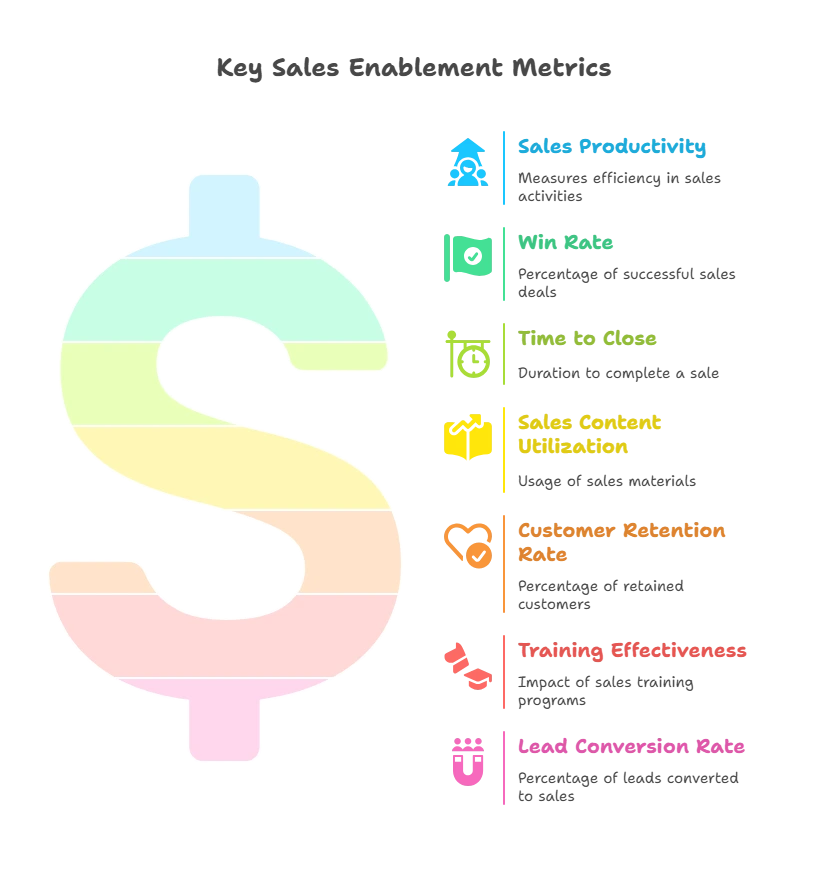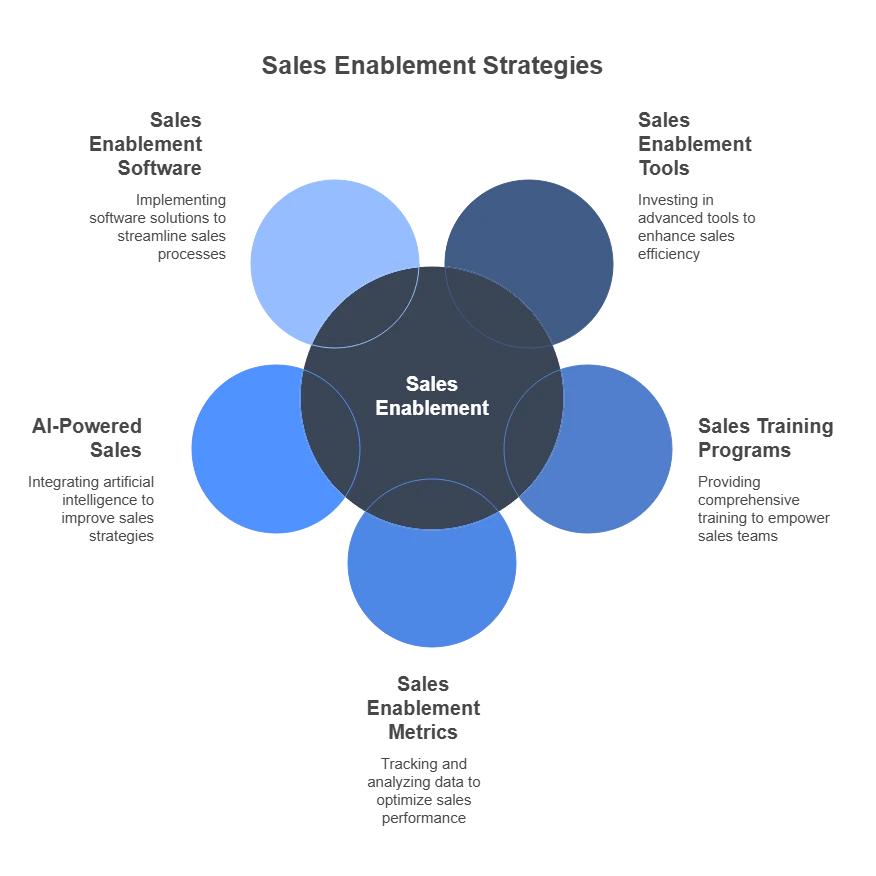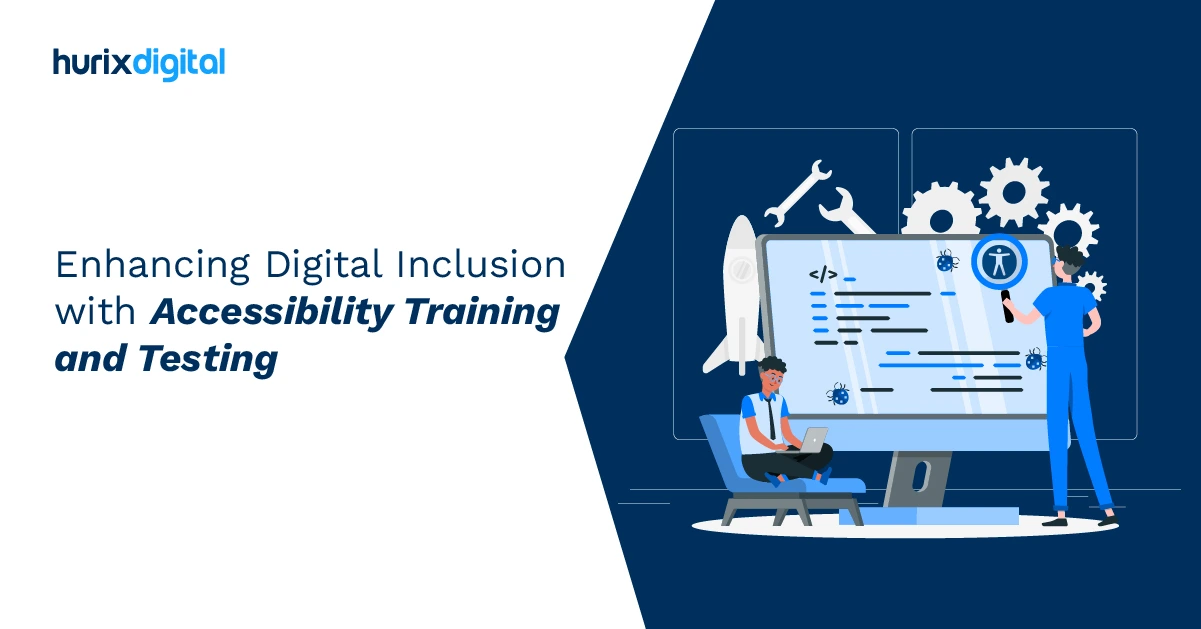
The Ultimate Sales Enablement Playbook for Revenue Growth!
Summarize with:
Sales enablement is like the foundation of a strong building for modern sales. It’s not just a fancy trick; it’s essential.
Think about it: a whopping 87% of the leading cloud companies are putting their money into sales enablement, and guess what? They’re seeing a significant boost in their revenue—8% more every quarter! This tells us something big: enabling sales function works, and it’s making a real difference in how companies sell their products or services.
Now, let’s examine this effective tool for sales success in more detail.
Table of Contents:
- What is Sales Enablement?
- What is the Importance of Sales Enablement?
- What is the Impact of Sales Enablement?
- Key Metrics for Sales Enablement
- Significant Sales Enablement Metrics
- Role of Sales Enablement Metrics
- Five Best Practices to Adopt in 2025
- Future Sales Enablement Trends Through 2025
- Conclusion
What is Sales Enablement?
Sales enablement simply means using tools and building strategies and processes to empower sales teams to generate more sales. With this process, your organization can increase sales productivity and help drive growth in revenue.
It equips the sales team with vital resources, including knowledge, sales enablement tools, and convenience to engage successfully with prospects and customers. By enabling sales for your organization, you can effectively unify your sales processes and create harmony between the sales team to fulfill business goals correctly.
What is the Importance of Sales Enablement?
Sales enablement is a crucial tool for powering up your sales team. Imagine it as a supercharge for their success, giving that extra push to their performance.
It encompasses vital techniques such as sales content management, sales training programs, metrics, and AI-powered processes that all work together to spearhead your sales growth.
- Sales content management involves organizing your sales resources and ensuring your team consistently has suitable tools available when needed.
- Sales training programs can help your sales team acquire the necessary skills to succeed. They cover all the essentials, from understanding the product to the art of making a sale.
- Sales enablement metrics let you assess the effectiveness of your sales strategies. They can measure deal size, the duration of the sales process, and success rates.
- Then, there’s AI-powered sales enablement. With AI, you can forecast customer behavior, customize your sales tactics, and automate tasks. All of this makes your sales process even more effective.
In this tech-savvy era, using tools like software and platforms is uncompromising. These tools offer extra help, strengthen and smarten your team, assist in sales training, improve content management, and streamline the sales process.
What is the Impact of Sales Enablement?
Today, more than ever, sales enablement is vital for your business. This means using sales tools and training programs to help your sales team sell more effectively. This leads to more sales and better customer relationships.
- One way this helps your team is by boosting their productivity. By giving them access to good sales content management tools and training, you can help them do more work in less time.
- Good sales software can also help your sales team better understand and meet customer needs, resulting in happier customers who will continue to do business with you.
- Another important part is collecting and understanding sales data. This can help identify what’s working and needs tweaking, leading to more business growth.
- Lastly, the latest AI technology can provide helpful tips and identify useful patterns in your sales data. This makes it easier for your sales team to make smart decisions based on solid facts.
Key Metrics for Sales Enablement
Let’s dive into metrics.
- The very first metric is the sales cycle length. It just means how much time a customer takes to buy something.
- Then, there’s conversion rates. They are basically the number of people who might buy and end up buying.
- Last on our list is revenue attainment. It’s simply comparing the money you’ve earned with the money you hoped to earn.
Significant Sales Enablement Metrics

The following are the key metrics to track:
1. Sales Productivity
The productivity and efficiency of your sales team is measured through:
- Percentage of time sales reps spend on selling compared to administrative work.
- The number of deals each rep deals with
Greater productivity means that resources are being put to work on impactful activities.
2. Win Rate
The percentage of closed deals to the total opportunities through:
- Winning percentage across all sales opportunities.
- Performance by product, region, or industry.
A high win rate indicates enablement delivers on its intended goals to influence sales success.
3. Time to Close
The average time it takes to close a deal from initial contact to final agreement through:
- The average duration of the deal cycle.
- The amount of time spent in each of the sales funnel stages.
The shorter, the closer, the more streamlined your processes and the more effective your enablement resources.
4. Sales Content Utilization
How frequently do reps engage with the enablement content that is available to them through:
- What percent of reps are using those particular assets?
- How often do customers interact with shared content?
High utilization indicates that the content is relevant to reps and customers.
5. Customer Retention Rate
Percent of customers that remain with a company over time through:
- Personal influence on customers’ staying power.
- Percent of customers lost in an interval.
Strong retention rates can be indicative of the successful enablement of customer relationships.
6. Training Effectiveness
The effectiveness of sales training on rep performance through
- Percentage of reps that have finished programs.
- Measures knowledge acquisition.
Shows ROI of enablement spend and which knowledge areas are lacking.
7. Lead Conversion Rate
The percentage of leads converted into opportunities or sales through:
- Number of conversions at each stage of the funnel.
- Conversion rates by each source.
This is a measure of the effect of enablement on the conversion and conversion rate of leads.
Role of Sales Enablement Metrics

Here, we will discuss the role of sales enablement metrics:
1. Track Progress
Sales enablement metrics are handy tools for tracking your ongoing sales activities. They provide clear-cut numerical values that showcase the real-time performance of your sales team.
Understanding these values can help you gauge your progress toward reaching your sales goals. Actionable steps include setting clear and measurable goals for your team, continuously evaluating performance, and incorporating improvements based on these metrics.
2. Boost Sales
AI-powered sales enablement is becoming increasingly important as we look to the future. AI can find patterns and guess how buyers will behave, making it easier for your sales team to close deals.
Here’s how you can use it: First, help your team learn AI technology. Next, start using AI-powered sales enablement tools. Finally, the system must always be monitored, and any changes must be made.
3. Equip and Educate with Sales Training Programs
Sales training programs are really important. They give your team the skills and know-how to make great sales.
Plus, ongoing training helps your team keep up with new trends and ways to sell. Don’t forget to make your training fit each person and team, update the training material often, and do good follow-up.
Five Best Practices to Adopt in 2025

Sales enablement promises remarkable transformations in the future. In 2025, we must ensure that your organization’s business strategies adapt to the ever-changing circumstances to build upon technological innovations.
Let’s look at some best practices for improving approaches:
1. Invest in Top-Notch Sales Enablement Tools
Advanced sales enablement tools are key to enhancing sales performance in 2025. These tools’ dynamic, AI-driven features can lead to significant efficiency gains.
Whether AI-powered sales enablement software for predictive analysis or inclusive platforms that incorporate sales content management and training, investing in state-of-the-art technology is non-negotiable.
These tools streamline various processes, automate data analysis, and offer insights to help strategically close deals.
2. Empower with Robust Sales Training Programs
Use detailed sales training programs to ensure the best performance from your sales team. Regular training that includes continuous learning and improving skills ensures your sales team is always aware of the latest techniques. Use practice situations, workshops, online learning, and pretend sales to make training fun and useful.
3. Leverage Sales Enablement Metrics
Get ready to unlock the potential of sales enablement metrics! These indispensable gauges offer a clear outlook on sales process success and shortcomings.
Monitoring key metrics such as lead response time, conversion rate, and customer interaction can help you adjust your tactics and boost your overall sales effectiveness.
4. Utilize AI-Powered Sales Enablement
Using AI-powered tools can help you succeed. Artificial intelligence (AI) can quickly collect and understand data, saving work hours.
It can highlight tendencies and hidden patterns that are hard to spot. This fast learning gives you an advantage, allowing you to closely study and cater to your clients’ habits individually.
5. Adopt a Sales Enablement Software
Enable your sales team with formidable sales enablement software. It should incorporate features like CRM, content management, and analytics to make the sales process seamless. Intuitive software can be a game-changer in ensuring your sales operations and processes keep pace with evolving trends.
Adapting these practices in the coming year will undoubtedly place your organization at the frontier of sales efficiency. Remember, having the right strategies and tools is equivalent to having a powerful engine that drives your sales team toward impeccable performance and growth.
Future Sales Enablement Trends Through 2025

Sales enablement has been transforming as emerging trends disrupt strategies by 2025. Key areas of development include:
1. Artificial Intelligence and Data Analytics
Artificial intelligence is changing the face of enabling sales and brings insights into buyer behavior, personalized content delivery, and the automation of routine tasks. Organizations adopting AI have experienced up to 50 %-win rates and a 70% cost reduction.
2. Hyper-Personalization
Advanced analytics enable extremely customized buyer experiences known to increase engagement and conversion. It is sales interactions that speak to them on a personal level and establish trust and authenticity.
3. AI in Marketing
AI can read data and patterns to provide hyper-personalized advertisements where companies can understand customer buying habits and create content accordingly. These trends show how technologies and custom approaches can improve practices by 2025.
4. Omnichannel Integration
The integration of digital and traditional sales channels ensures a consistent buyer experience. Unified CRM platforms connect email, social media, and live chat data for cohesive communication.
5. Real-Time Analytics
Real-time dashboards track sales metrics like engagement rates, pipeline progress, and win rates to enable teams to quickly adapt strategies. If content performance feedback arrives in real-time, it can inform reps what is working and what is not with clients.
Conclusion
Sales enablement involves giving them the right tools, ensuring sales and marketing work together, creating interesting content, and providing effective training to boost sales. Using technology and keeping track of results helps refine strategies while simplifying processes and encouraging teamwork, ensuring things run smoothly.
At Hurix Digital, we’re here to guide you on this journey. Our process combines proven methods with the latest technology. We focus on tools powered by artificial intelligence and data insights to ensure your sales team is not just ready but set up for success.
With Hurix Digital, you can expect real sales changes, leading to steady growth and a healthier bottom line. Step into the future of sales with us, where sales enablement isn’t just a concept but a concrete way to drive your success forward.
Summarize with:

Vice President & SBU Head –
Delivery at Hurix Technology, based in Mumbai. With extensive experience leading delivery and technology teams, he excels at scaling operations, optimizing workflows, and ensuring top-tier service quality. Ravi drives cross-functional collaboration to deliver robust digital learning solutions and client satisfaction
 Upcoming Masterclass | Build an Army of Brand Evangelists using Training & Development | November 20th, 8:30 AM PDT | 11:30 AM EDT | 10:00 PM IST
Upcoming Masterclass | Build an Army of Brand Evangelists using Training & Development | November 20th, 8:30 AM PDT | 11:30 AM EDT | 10:00 PM IST




